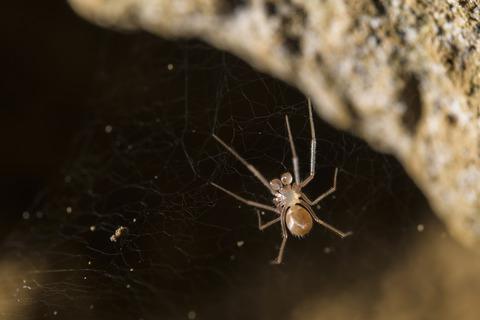当前位置:
X-MOL 学术
›
Funct. Ecol.
›
论文详情
Our official English website, www.x-mol.net, welcomes your
feedback! (Note: you will need to create a separate account there.)
Environmental filtering and convergent evolution determine the ecological specialization of subterranean spiders
Functional Ecology ( IF 4.6 ) Pub Date : 2020-01-31 , DOI: 10.1111/1365-2435.13527 Stefano Mammola 1, 2, 3 , Miquel A. Arnedo 4 , Cene Fišer 5 , Pedro Cardoso 2 , Andrea J. Dejanaz 3 , Marco Isaia 3
中文翻译:

环境过滤和融合演化决定了地下蜘蛛的生态专长
更新日期:2020-01-31
Functional Ecology ( IF 4.6 ) Pub Date : 2020-01-31 , DOI: 10.1111/1365-2435.13527 Stefano Mammola 1, 2, 3 , Miquel A. Arnedo 4 , Cene Fišer 5 , Pedro Cardoso 2 , Andrea J. Dejanaz 3 , Marco Isaia 3
Affiliation

|
- Ecological specialization is an important mechanism enhancing species coexistence within a given community. Yet, unravelling the effect of multiple selective evolutionary and ecological factors leading the process of specialization remains a key challenge in ecology. Subterranean habitats provide highly replicated experimental arenas in which to disentangle the relative contribution of evolutionary history (convergent evolution vs. character displacement) and ecological setting (environmental filtering vs. competitive exclusion) in driving community assembly.
- We tested alternative hypotheses about the emergence of ecological specialization using the radiation of a lineage of sheet‐weaver cave‐dwelling spiders as model system. We observed that at the local scale, a differential specialization to cave microhabitats generally parallels moderate levels of morphological similarity and close phylogenetic relatedness among species. Conversely, geographic distance contributed little in explaining microhabitat occupation, possibly mirroring a limited role of competitive exclusion. Yet, compared to non‐coexisting species, co‐occurring species adapted to different microhabitats showed lower morphological niche overlap (i.e. higher dissimilarity) and deeper genetic distance.
- The framework here developed suggests that in the subterranean domain, habitat specialization is primarily driven by environmental filtering, secondarily by convergent evolution, and only marginally by character displacement or competitive exclusion. This pattern results in the establishment of replicated communities across geographical space, composed by ecologically equivalent species. Such process of community assembly well explains the numerous adaptive radiations observed in subterranean habitats, an eco‐evolutionary pattern well documented in oceanic islands or mountain summit communities.
中文翻译:

环境过滤和融合演化决定了地下蜘蛛的生态专长
- 生态专业化是增强特定社区内物种共存的重要机制。然而,揭示导致专业化进程的多种选择性进化和生态因素的影响仍然是生态学中的关键挑战。地下栖息地提供了高度复制的实验场所,在其中可以区分进化史(趋同进化与角色置换)和生态环境(环境过滤与竞争排斥)在推动社区聚集方面的相对贡献。
- 我们使用薄板洞穴洞穴蜘蛛世系的辐射作为模型系统,测试了有关生态专业化出现的其他假设。我们观察到,在局部尺度上,洞穴微生境的差异化专业化通常平行于中等水平的物种之间的形态相似性和紧密的系统发育相关性。相反,地理距离对解释微栖息地的占领贡献很小,可能反映了竞争性排斥的有限作用。然而,与不共存的物种相比,适应于不同微生境的共生物种显示出较低的形态学生态位重叠(即较高的相似性)和更深的遗传距离。
- 此处开发的框架表明,在地下领域,栖息地专业化主要是由环境过滤驱动的,其次是由趋同进化而来的,而仅由角色置换或竞争性排斥而仅是边际的。这种模式导致在整个地理空间中建立由生态等效物种组成的复制群落。这样的社区集会过程很好地解释了在地下栖息地中观察到的许多适应性辐射,这是在海洋岛屿或山顶社区中充分记录的生态进化模式。









































 京公网安备 11010802027423号
京公网安备 11010802027423号